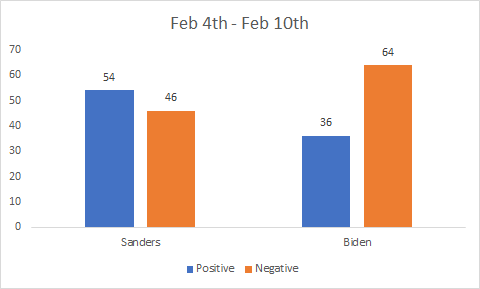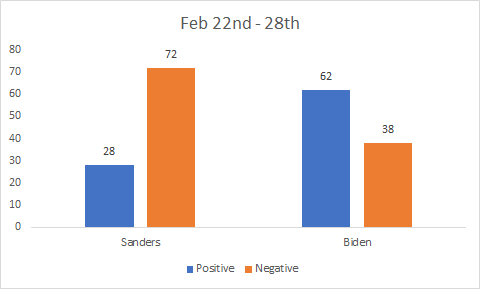New Analysis supports claims of media bias against the Vermont Senator during his 2020 Presidential Run.
In Noam Chomsky’s Book Manufacturing Consent the author discusses how the concentration of media ownership can narrow or exclude any rational discussion about economic policies. Chomsky in his book says “Large corporate advertisers…will rarely sponsor programs that engage in serious criticisms of corporate activities, such as the problem of environmental degradation, the workings of the military-industrial complex, or corporate support of and benefits from Third World tyrannies (Chomsky, 1992).” One of the consequences of this type of system is that among candidates running for office, whose policies run counter to the corporate profits of a major news organization, they are either excluded (media blackout), taken out of context, or demonized.

Throughout the 2020 Democratic Presidential Primary there was a lot of criticism regarding media coverage of Vermont Senator Bernie Sanders. This was evident in media coverage on MSNBC during their prime time (Marcetic, 2019). Bill O Reilley before Super Tuesday said “The journalism industry, in print and television, is top-down corporate. The Corporations control it…The Corporations do not want Bernie Sanders to win. It’s obvious. (Bill O Reilley, 2020).” Seth Meyer noticed this too as he discovered an MSNBC graph merging three candidates vs Sanders. “That’s right because if you combine the votes of Biden, Buttigieg, and Klobuchar you can beat Bernie, now all you have to do is find a way to genetically combine them into one candidate called the Klobu-Biden-Butti-char (Late Show with Seth Meyers, 2020).”

If coverage was so biased that Meyers and O Reilley noticed, could that have occurred in online coverage as well? How bias was it towards Sanders leading up to that critical moment of Super Tuesday? How much was there and was there a trend? Using my background in data analysis, I decided to find out.
Methodology
The first source was an InTheseTimes study of Positive and Negative coverage of Sanders, Biden, and Warren and an article by Salon on how Biden earned between $70.9 to $100 million in the equivalent of free advertising leading up to Super Tuesday. A Washington Post article by CNN reporter Chris Cillizza writes about a survey which revealed 60% of Americans read the headline and only 25% read the whole article. For this project I did what three-fifths of Americans did, read only the headline. I analyzed positive or negative connotations in the top twenty news headlines from each these seven mainstream media news sources: CNN, MSN, The Washington Post, The Atlantic, The New York Times, Politico, and the Los Angeles Times. For this project I focused on the headlines of the article, but if the tone was neutral, I read the article.
I typed in the candidate’s name and the news networks name for this project and proceeded to analyze whether the tone was positive or negative. Each article was worth one point and then assigned under the corresponding candidate’s name. If a CNN headline said “Can Bernie Sanders or the Coronavirus be stopped?” one point went into the negative column under Sanders, but if a CNN headline read “Joe Biden surges ahead in the polls” one point went into the positive column under Biden. I excluded videos and only focused on coverage read in an online format.
I used Google Tools and took advantage of their settings to search for any articles related to both Biden and Sanders. Since exit polls indicated that 62% of primary voter cast ballots in February and March alone, I focused on how both candidates were covered from mid-January to the day before Super Tuesday.
Here are the results of media coverage of Bernie Sanders and Joe Biden over the course of six weeks.

Two weeks before the Iowa Caucus, Bernie Sanders had surpassed Joe Biden in that state and by the end of this period was leading by five points. Yet he received 41% positive coverage, while the person in second place, Joe Biden, received 66% positive coverage.

In the week leading up to the Iowa Caucus the coverage of Bernie Sanders was quite negative compared to Joe Biden. In the Iowa Caucus Bernie Sanders was leading by 23% while Joe Biden was at 19.3%. Normally a candidate leading in the polls in the first state of a Presidential primary correlates with positive media coverage, instead the opposite happened. Joe Biden who would place fourth in Iowa received 71% positive coverage while Bernie Sanders who won the popular vote in Iowa got 33% favorable coverage.

Out of the 132 headlines analyzed Sanders received 85% negative coverage from the New York Times and the Washington Post. Looking at the number of subscribers it’s likely to have played a role in the primary given how many readers they had: New York Times (nearly 5 million), the Washington Post (over 2 million). These were one of the two most trusted news sources among Democrats, 65% were over the age of 45 in last year’s primary.

The results were somewhat surprising but not shocking. As it became evident that he won the popular vote the Vermont Senator received positive coverage for the first time, while Joe Biden received negative coverage. On February 9th Bernie Sanders became the official frontrunner in national polls at 23% to Biden’s 21% among eight other candidates.
Tsunami of Negative Coverage

As Bernie Sanders secured his new status as the frontrunner he experienced a tsunami of negative coverage. The coverage cast doubt on his chances of winning despite him doing as well as Biden, brought up his already released medical records, implied he was a traitor to Russia (who he wanted to sanction), and that he can’t unify the party. CNN provided 85% negative coverage to Sanders in their headlines, meanwhile Joe Biden (who placed fifth in NH with 0 delegates) earned only 50% negative coverage.

After Bernie Sanders won a blowout victory in the Nevada Caucuses, even his doubters like Nate Silver finally conceded that he was the frontrunner. On average the Vermont Senator was leading nationally 29.3% while his rival Joe Biden was at 17.83%, nearly twelve points over his rivals. As he surged nationally, he simultaneously experienced another wave of negative coverage. This ranged from comparing Bernie Sander’s Nevada win to the fall of France to Nazi Germany, to the New York Times opinion pieces, to taking his quote about Cuba’s education out of context while President Obama said the same thing. Meanwhile Joe Biden faced almost no scrutiny over his Feb 25th claim that he was arrested in South Africa with Nelson Mandela during apartheid. CNN once again gave Sanders 85% negative coverage in their headlines after his NV victory, followed by the Washington Post at 70%, and the New York Times and Los Angeles Times both gave him 65%.

Between the South Carolina primary and Super Tuesday an analysis by Critical Mentions (a media tracking service company) discovered that Joe Biden earned $ 71.9 million in earned national media coverage (Vanity Fair, 2020). That doesn’t factor in the local news coverage “so his campaign’s earned…media could have reached at least $100 million.” While Sanders received $156 million in earned media the coverage was overwhelmingly negative. According to Ian Sams, former press secretary for Kamala Harris’s 2020 campaign “It’s hard to overstate the powerful influence of earned media in this primary . . . Narratives keep superseding ad spend, field organizing, rallies, and all the old metrics.”
Earned or free media coverage can influence who the Democratic primary voters select as their nominee. In 2020, 65% of the Democratic primary voters were 45 and older and a Gallup poll later that year showed that trust in media among Democrats soared from 51% in 2016 to 73% four years later . This likely contributed to why older voters backed Joe Biden over Bernie Sanders. And despite the fact that Joe Biden mentioned he was arrested with Nelson Mandela, none of the seven news organizations scrutinized his false statement. 44% of primary voters cast their vote for President in March alone.

Over the course of six weeks I analyzed 766 articles that mentioned Bernie Sanders and 767 articles that mentioned Joe Biden. Between January 19th through March 2nd, Bernie Sanders received 64.2% negative coverage whereas Joe Biden received 60.6% positive coverage. Over the six weeks as Sanders surged passed his rival and was polling well in certain states, the there was an equal uptick in negative headlines for him with the exception between Iowa and New Hampshire. As it became clear that he could plausibly win, the news media manufactured consent among older voters to persuade them that he couldn’t win despite evidence to the contrary. While Sanders was the frontrunner for 22 out of 44 days, he received nearly two-thirds negative mentions which brings up another interesting fact.
Among twelve of the Super Tuesday states that cast a ballot, 44% of them voted in the first three days of March right around the time Vice President Biden experienced an enormous wave of positive press coverage.


Although there were other factors in play from three candidates dropping out to endorse his rival, to Elizabeth Warren splitting the vote, that doesn’t explain why exit polls showed a discrepancy between states that supported Medicare for All and free college ended up voting for Biden. Overall tone of the headlines demonstrated a clear attempt to paint the Vermont Senator as unelectable despite the fact that he was polled better in the swing states of Wisconsin, Michigan, and Pennsylvania than Biden. The fear mongering, ridicule, and dismissive coverage of Sanders persuaded enough Democrats forty-five and older that Biden must be the “safe choice” that they supported a conservative Democrat over a progressive reformer.
Anyone in the mainstream news media who claims that Bernie Sanders was treated fairly during the primary, is not telling you the truth. The data suggests he was not covered fairly. The negative coverage against Senator Sanders while he was the frontrunner is unusual for one reason: Today’s television and print media are corporate controlled. Any candidate that offers any mild reforms that would break up monopolies represent an existential threat to their power structure.
The fact that Bernie Sanders despite all that negative attention was able to temporarily break through that narrative, and become the frontrunner for a while is remarkable. If the coverage had treated the candidate as though the frontrunner that we was according to polls there’s no doubt that he’d be in the Oval Office today. What these results indicate is an institutional bias against presidential candidates running for president that conflict with the corporate sponsorship of news networks. The next left leaning candidate must have a much more aggressive counter narrative that either gets around corporate media or forces them to have no choice but to cover it. Hopefully the next candidate prepare for this in the future.
Special Thanks to YouTuber Spencer Snyder for making a video about this analysis.
Link: Majority Headlines BIASED against Sanders During Primary | New Analysis — YouTube
